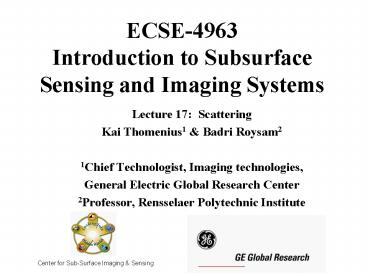ECSE4963 Introduction to Subsurface Sensing and Imaging Systems - PowerPoint PPT Presentation
1 / 17
Title:
ECSE4963 Introduction to Subsurface Sensing and Imaging Systems
Description:
A key application of this takes advantage of the Doppler effect. ... PET, Nuclear medicine. High velocity Doppler jet, hence a leaky cardiac valve. Homework 13 ... – PowerPoint PPT presentation
Number of Views:25
Avg rating:3.0/5.0
Title: ECSE4963 Introduction to Subsurface Sensing and Imaging Systems
1
ECSE-4963Introduction to Subsurface Sensing and
Imaging Systems
- Lecture 17 Scattering
- Kai Thomenius1 Badri Roysam2
- 1Chief Technologist, Imaging technologies,
- General Electric Global Research Center
- 2Professor, Rensselaer Polytechnic Institute
Center for Sub-Surface Imaging Sensing
2
Recap
- We have reviewed the use of phase in coherent
signal processing. - A key application of this takes advantage of the
Doppler effect. - Blood flow detection in medical ultrasound has
been used as an example. - Basic equations governing Doppler processing were
derived.
3
Acoustic Imaging SSI
Probes
Detectors
Surface
Medium
object
Medium
Object
Probe
Optical/IR
Electro- magnetic
Fluorescence
Absorption
X-ray
Acoustic
Absorption
Nonlinear Absorption
Dispersion
CW
Pulsed
Modulated
Nonlinear Scattering
Scattering
Scattering
Multi- Spectral
Partially Coherent
Coherent
Diffusion
Diffusive
Phase Object
Clutter
Quantum
Classical
Depolarizing
Inhomogeneous/ Layered
Outside
Inside
Auxiliary
Stationary
Moving
Rough Surface
4
Some More on Scattering
When a plane wave strikes a small object
(particle), a portion of the wave is scattered
into all directions. The scattered wave has an
angular distribution that depends on the
scatterers geometry and dimensions in relation
to the wavelength of the incoming wave, as well
as the contrast between the scatterer and the
surrounding medium.
l
Rayleigh Scattering Dimensions of scatterer are
much smaller than l
Incident wave
Back scattering
Forward scattering
l
Incident wave
Mie Scattering Dimensions of scatterer are NOT
much smaller than l
l
Incident wave
5
Some more on scattering
- Some terminology
- Scattering target size similar or less than
wavelength - Reflection target size much larger than
wavelength - In acoustics, scattering or reflection arises
from variations in either density or
compressibility - Why are density or compressibility important?
- Are there comparable quantities in
electromagnetics?
6
More on Scattering
- There is a difference in scattering caused by
density variation compressibility variation - Monopole scattering
- Compressibility variation
- Dipole scattering
- Density variation
7
Scattering
Assumes l gtgt size of obstacle
Scattered waves
Cross section
s scattered intensity/unit solid angle
incident wave intensity
incident
For a particle of volume V in homogenous medium
k compressibility r mass density
p particle m surrounding
medium
Blood shows f4 dependence, other tissue types
weaker dependence
8
More on Scattering
- Why is this monopole/dipole distinction
important? - There are many targets with large density or
compressibility variations. - Land mines
- Breast microcalcifications
- Hand grenades in luggage
- To identify dipole scattering, we have to measure
angular backscatter. - Clinical research into angular scatter on-going.
9
Images from scattering targets
- So far, we have talked about backscatter from
single scatterers. - Image will be a convolution of the scattering
cross section and the point spread function. - What if we have a huge number of random
non-resolvable scatterers? - Image will be composed of speckle noise.
- Speckle noise image does not represent the
underlying structure.
10
Scattering and Speckle scattering
element is smaller than dimensions of ultrasound
pulse
Echoes from multiple scattering points generated
simultaneously
Pattern of constructive and destructive
interference from random scatterers in
homogeneous tissue gives rise to speckle in
resulting ultrasound image
11
Speckle noise reduction by Spatial Diversity
- Left hand image shows a conventional ultrasound
acquisition. - Right hand image shows acquisition from multiple
angles. - The images from these angles have independent
speckle. - Adding these images after detection will improve
the SNR.
12
Some examples
- The images shown are of a breast cyst.
- Left hand image shows the speckle noise
structure. - Right hand image shows the improved detectability
of tissue structures cyst with spatial
compounding.
13
More examples
- A secondary breast tumor was discovered adjacent
to the primary tumor using spatial compounding.
14
On Things That Stick out in SSI Images
- Probe/target interactions what has been
helpful? - X-ray, CT, Optics
- Attenuation variations
- Acoustics
- Variation in backscatter strength
(compressibility, density) - Tissue (e.g blood) motion
- Two types of interactions
- Ones needed to form structure of basic image
- Our basic contrast mechanisms
- Humans needed to view images, make decisions
- Smoking guns for a given clinical situation,
target identification - Luggage inspection, explosives detection (image
processing based) - PET, Nuclear medicine
- High velocity Doppler jet, hence a leaky cardiac
valve
15
Homework 13
- Identify two other probes (other than ultrasound)
which exhibit speckle noise. - Discuss means for speckle noise reduction for
those probes. - Identify analogs for compressibility and density
variations for electromagnetic probes. Justify
your choices. (In other words, what causes
scattering with electromagnetic radiation?)
16
Instructor Contact Information
- Badri Roysam
- Professor of Electrical, Computer, Systems
Engineering - Office JEC 7010
- Rensselaer Polytechnic Institute
- 110, 8th Street, Troy, New York 12180
- Phone (518) 276-8067
- Fax (518) 276-6261/2433
- Email roysam_at_ecse.rpi.edu
- Website http//www.rpi.edu/roysab
- NetMeeting ID (for off-campus students)
128.113.61.80 - Secretary Betty Lawson, JEC 7012, (518) 276
8525, lawsob_at_.rpi.edu
17
Instructor Contact Information
- Kai E Thomenius
- Chief Technologist, Ultrasound Biomedical
- Office KW-C300A
- GE Global Research
- Imaging Technologies
- Niskayuna, New York 12309
- Phone (518) 387-7233
- Fax (518) 387-6170
- Email thomeniu_at_crd.ge.com, thomenius_at_ecse.rpi.edu
- Secretary Betty Lawson, JEC 7012, (518) 276
8525, lawsob_at_.rpi.edu































